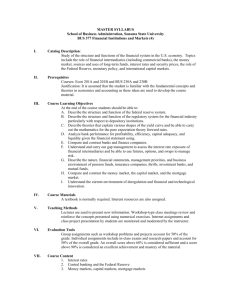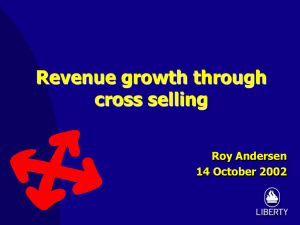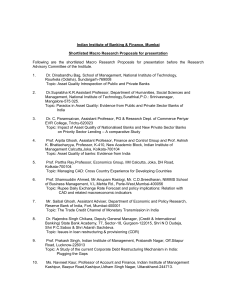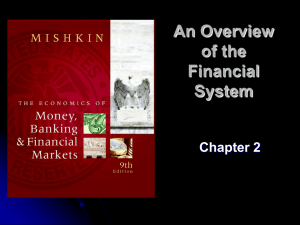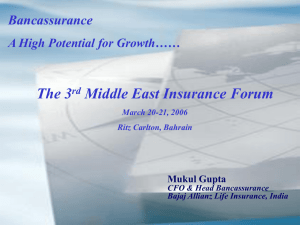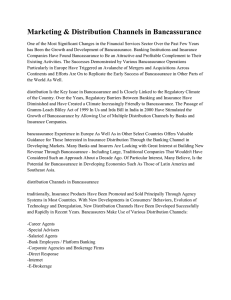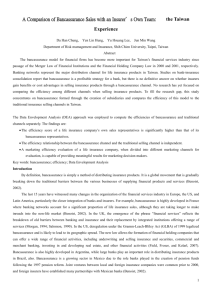Marketing of Insurance: An Indian Perspective Dr. Vipul Jain
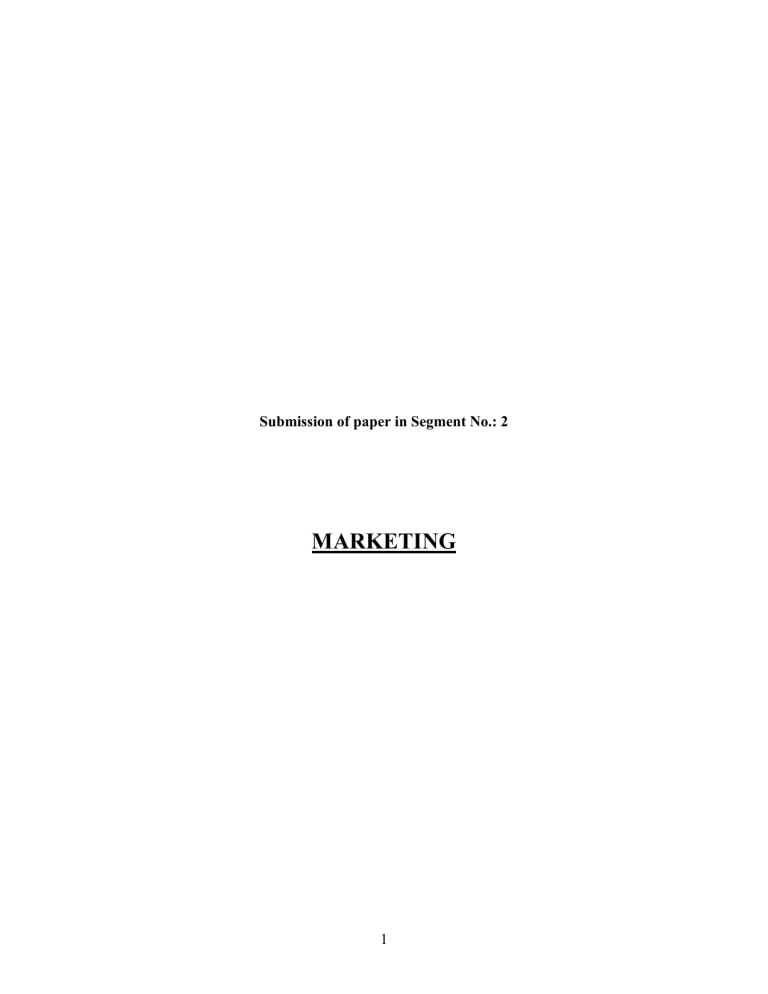
Submission of paper in Segment No.: 2
MARKETING
1
Marketing of Insurance: An Indian Perspective
About the Author:
Dr. Vipul Jain: Associate Professor and Head, Department of Management
Sciences, Technology Education and Research Integrated Institutions (TERII),
Kurukshetra (Haryana).
Formally, with Max New York Life Insurance Co. Ltd. and having 12 years of varied professional experience in different capacities in the area of Sales Management, Marketing Management, Channel Management,
Strategy Formulation and Business Development.
E-mail : vipuljain17@gmail.com
Contact No. : 9729288188
CERTIFICATE OF AUTHENTICITY
This is to be certified that the paper titled “Marketing of Insurance – An Indian perspective” is my own work. It has not been published anywhere in any form.
It is also not in consideration anywhere for publication.
The content is original to the best of my knowledge.
Sd/-
Dr. Vipul Jain
(M.B.A., Ph.D.)
2
Abstract
Marketing is basically the interaction of company and/or product with consumer.
Main motive of the interaction with consumer is that to influence and attract the consumer toward the company and/or company’s product and/or services.
Insurance marketing is also just the marketing of insurance products. Marketing of this sort is an important tool when it comes to the business of insurance. The marketing of insurance readily happens in the life insurance department as well as the non-life insurance department. This paper discuss about the marketing of insurance in an Indian perspective, especially considering the socio-cultural ethos of the market and the fitment of the distribution channels in to it, along with where the various companies face challenges and bottlenecks. Whenever any debate arises about the intermediaries and distribution channels, the discussion veers to technology and its impact on distribution. However, the author believe that the basic existential problems being faced by the channels in this market needs to be looked in to first, because place is a key element of marketing mix.
Place is also known as channel, distribution, or intermediary. It is the mechanism through which goods and/or services are moved from the manufacturer/ service provider to the end user or consumer and then the question of enablers – technology, tools, training, learning etc. is to be taken up.
Key Words:
Voluntary Retirement Scheme, Personal Distribution Systems,
Direct Response Distribution, Attrition
3
Introduction
Insurance is a form of risk management primarily used to hedge against the risk of a contingent, uncertain loss. It is the equitable transfer of the risk of a loss from one entity to another, in exchange for payment.
In India, it has been eleven years, since the insurance market has been opened up, and the new entrants in to the market have set up shop in most of the cities. The public sector companies have already established themselves in the market. But there are multiple challenges face by theses insurance companies, of which two are critical:
Designing the products suiting the market
Using the right marketing strategies to reach all customer segments.
While the companies have been quite successful in dealing with the first of these challenges using the existing product features and leveraging the technical know-how of their partners, most are still grappling with the right channel mix for reaching potential customers.
Distribution Scenario in the Indian Market
In today’s Indian insurance market the challenge to insurers and intermediaries is two-pronged:
Building faith about the company in the mind of the client.
Intermediaries being able to build personal credibility with clients.
4
Traditionally tide agents have been the primary channels for insurance distribution in the Indian market; the public sector insurance companies had their branches in all most all parts of the country and have attracted local people to become their agents. The agents are from various segments in society and collectively cover the entire spectrum of society. A person who has lived in the locality for many years sells the products of the insurance company with a local branch nearby. This ensures the last mile touch point being closure to the customer. Of course, the profile of the people who acted as agents suggests they may not have been sufficiently knowledgeable about the different products offered, and may not have sold the best possible product to the client.
Nonetheless, the customer trusted the agent and the company. This arrangement worked adequately in the absence of the competition.
In today’s scenario agents continue as the prime channel for insurance distribution in India, as is the case in most markets, supported by call centers to a small extent.
Challenging Scenario: Demanding Role Transformation of Intermediaries
Insurance has to be sold the world over, and the Asian Market is no exception.
The touch point with the ultimate customer is the distributor or the producer and the role played by them in insurance markets is critical.
It is the distributor who makes the difference in terms of the quality of advice choice of product, with their distinct cultural and social ethos, these conditions will play a major role in shaping the distribution channels and their effectiveness.
In today’s scenario, insurance companies must move from selling insurance to marketing an essential financial product. The distributors have to become trusted
5
financial advisors for the clients and trusted business associated for the insurance companies.
The distinction of channels in the developed markets is personal distribution systems and direct response systems. Personal Distribution Systems include all channels like agencies of different models and brokerages, bancassurance and work site marketing. Direct Response Distribution Systems are the method whereby the silent purchases the insurance directly. This segment, which utilizes various media such as the Internet, tele-marketing, direct mail, call centers, etc., is just beginning to grow.
What should the companies look at?
Basically companies have to take a look at the intermediaries they are using, weather it is optimal to use them, and what are alternatives?
Mostly, the new companies have attempted appealing to the middle, upper middle and elite classes in the major cities. Contrasted with public sector insurance companies, with their offices across the country, the new companies have miles to go before they reach anywhere. They must overcome the mindset of the customer that life insurance is Life Insurance Corporation of India (LIC) and general insurance is General Insurance Corporation of India (GIC), if they hope to grow in the market. Meanwhile, the public sector companies are going to great lengths to revamp their image to look and feel more contemporary.
Both the public and new private companies are fighting their own battles from the perspective of customer perception management:
6
Public Sector Companies:
Identity is well established, but the perception of "poor service providers" is a stigma.
Products are not attractive and flexible enough but expansive.
To retain their creamy layer clientele who are the most likely to be wooed by the new companies.
Match the aura created by the new companies in the urban market.
Private Sector Companies:
Have to build their identity in a market where the public does not distinguish them.
Remove the perception that anything that looks good is expensive.
Work against the people's mindset that they are not here for the long term.
Attract intermediaries especially agents with the requisite qualifications and attributes who can market the company and the product.
Run the risk of tapping an already insured market for repeat insurance instead of tapping new virgin pockets in the market.
In this process all are targeting the same market – the existing pie is being cut up further, but no attempt is being made to increase the size of the pie. For example, while attempts are made to complete the quota of rural insurance in percentage terms, the rural market potential is yet to be tapped, as the new insurers are not able to attract the right kind of talent in to their distribution force to address this.
Intelligent segments of distribution channels to match the market segmentation are what will help the companies to move in this direction.
7
Focus on Multiple Distribution Channels
Though a multi-channel strategy is better suited for the Indian market as well, it is important to keep in mind that this market is really a conglomeration of multiple markets. Each of the markets with in this conglomeration requires a different approach. Apart from geographical spread the socio-cultural and economic segmentation of the market is very wide, exhibiting different traits and needs. Let us look at the various insurance distribution channels and the challenges faced by them from theses perspectives.
Agents
Today’s insurance agent has to know which product will appeal to the customer, and also know his competitor’s product in the same space to be an effective salesman who can sell his company, the product and himself to the customers.
The private companies are looking for educated, aware individuals with marketing flair, an elite group who can be attracted only with high remuneration and the lure of a fashionable job, all of which may not be possible in this business with its price pressure and the complexity of selling insurance. Unable to attract this segment, they have started easing recruitment conditions as against the stringent norms they had earlier, thereby diluting the process.
While the public sector companies are able to attract agents, they continue to suffer from high attrition rates due to indiscriminate agent appointment. The most successful of these companies tied agents are hardly of the elite variety of salesman. They are still the neighborhood do gooders – the postman, the school teacher, and the shopkeeper – who know the people and are themselves known in
8
the community. The challenges here are the lack of knowledge of the competitive market and the inability to do intelligent comparisons with the competitor’s products. Educating and training these agents is a serious challenge for the insurance companies.
Another social feature in the market is the considerable respect for age in Indian society and a belief that an older person knows better. A very young up-market agent who is a typical salesman may not appeal to a large segment of the middle class, which is looking for a solid trustworthy person from whom they can buy insurance.
In this context, it might be a rewarding exercise to recruit some older people (who have take VRS from banks and other financial institutions) to sell some lines of products like pension plan, annuities etc.
Gender of agent is another relevant feature in the rural context that makes a difference, especially for the female population. Women to whom the customers can relate viz nurses, gram sevikas, who can target the female segment of the population more effectively. What is applicable for the rural women and children health programs and population control programs is equally applicable for insurance selling also. For Instance, Max New York Life Insurance Company
Limited has adopted a version of this strategy by appointing gram sahayaks to sell and service the rural customers.
With this kind of segmentation of intermediaries, the main challenges for the insurance companies lies in training and educating those people to become effective sales persons.
9
Banks
Bancassurance in India is a new concept. In our country the banking & insurance sectors are regulated by two different entries.
* Banking is fully governed by RBI and
* Insurance sector is by IRDA
Bank assurance being the combination of two sectors comes under the purview of both the regulators.
Banks in India are all pervasive, especially the public sector banks. They became the foremost channels for distribution of insurance. There are certain tie-ups between the Insurance companies & banks are given at present days these tie-up are going well, running well & past in the field of Bancassurance.
(1) LIC: The insurance company LIC of India have tie up with the following bank for bancassurance. Some of them are: -
(A) Corporation Bank
(B) Punjab National Bank
(C) Vijaya Bank
(D) Dena Bank
2) SBI Life Insurance Co: The SBI life Insurance Co Ltd is starting & Running its Insurance business with the help of S.B.I.
3) Max New York Life Insurance Co. Ltd. (MNYL): MNYL is running its bancassurance business with the help of Axis Bank Limited.
10
4) Bajaj Allianz general Insurance Co. Ltd: In the field of general Insurance the Bajaj Allianz General Insurance Co Ltd., has some tie-ups with Dena Bank,
Punjab & Sindh Bank and Centurian Bank.
5) Birla Sun life Insurance Co. Ltd : The Birla Sun life Insurance Company has a tie-up with the HDFC Bank and Citi Bank for the insurance purpose:-
Inspite of above mentioned tie-up with banks. There are many tie-ups for the purpose of bancassurance, like ICICI Prudential, United India Insurance Co-Ltd. and so on.
Advantages of Bancassurance:
Bancassurance is a tool, which is beneficial to bank, customer & Insurer at a time. There are certain benefits of bancassurance are given:-
(1) From banks point of view : -
(A) By selling the insurance product by their own channel the banker can increase their income.
(B) Banks have face-to-face contract with their customers. They can directly ask them to take a policy. And the banks need not to go any where for customers.
(C) The Bankers have extensive experience in marketing. They can easily attract customers & non-customers because the customer & non-customers also rely on banks.
(D) Banks are using different value added services like e-banking, tele-banking, direct mail and so on, they can also use all the above – mentioned facilities for bancassurance purpose with customers and non-customers.
11
(II) From insurer point of view:
(A) The Insurance Company can increase their business through the banking distribution channels because the banks have numbers of customers.
(B) By cutting cost insurers can serve better to customers in terms of lower premium rate and better risk coverage through product diversification.
(III) From customers' point of view :
Product innovation and distribution activities are directed towards the satisfaction of needs of the customer. Bancassurance model assists customers in terms of price, diversified product, quality in time & door step services by the banks.
Disadvantages of Bancassurance
(I) Viability for the banks to take up as bancassurance is a volume business.
(II) Training of people and lack of vision and awareness.
(III) Useful for selling only certain lines of products.
(IV) Initial Investment in system, process and training.
The strategy should be used multiple banks according to their presence in different regions. Success would come by using bancassurance where it will be most effective i.e. selling simple, cheap products to the masses at a low cost. This awareness is growing and is evident from the fact that nearly every insurance company has partnered with one or many banks to implement bancassurance.
12
Brokers
This is a new experience for the insurance customer, accustomed to brokers in financial services, real estate and travel & tourism. For historical reasons the image that ‘broker’ carries in the minds of the customer is not very favorable.
Thus the new breeds of insurance brokers face the challenges of establishing credibility.
The positives are that brokers in the urban arena can attract the elite and the upper middle class customer. Brokers represent the customer and can sell the products of more than one company. They seek to determine the best fit for the client and can effectively address the mind block faced by the public about the various companies. This is applicable in the case of life insurance for the high-end and corporate/group segment.
In the non-life segment, broking is not entirely new, as reinsurance brokers were arranging exotic covers. For individual customers also, with a wide range of competitive products, the brokers can get a good deal. The corporate broking companies will have to play a prominent role.
If NGOs’ based in rural areas can be attracted effectively in to the rural sector co-operatives arena, they stand a good chance of succeeding and can help the new players get a foothold in the rural market. These are the players with the potential to make the difference, as they have the trust of the people, like milk co-operatives in Gujrat selling insurance in addition to milk production and distribution. It would be a new dawn in Indian insurance distribution. With the right impetus the Indian rural insurance scenario could be one with high business volume and tremendous growth potential.
13
Work Site Marketing
This area needs to be tapped, as in any country one of the biggest markets is through the worksite. With the changes in human resources management policies and compensation packages, group products or worksite products do have a definite market that can not be ignored.
Here the advantage would be:
Captive customer base.
Potential to sell individual insurance and group insurance.
High trust factor.
High hit ratio for the intermediaries.
The challenges would be the cost effectiveness, product customization and efficient post sales servicing, which would determine continued business.
Technology has a key role to play in worksite marketing to ensure cost benefits.
Banks and financial institutions have been successfully marketing credit cards and other financial products using this channel. If not an identical model a similar approach can be used for selling insurance.
Internet
Though India is joining the fast growing breed of net users, using net for transactions has not yet caught up. Though a few banks provide online banking, the usage is still a small fragment. The insecurity associated with transactions over the net is still an inhibiting factor. At present most of the insurance companies have product information and/or illustrative tools on the web.
14
We do not see the web evolving in to a means for direct selling of insurance in the current scenario. In the Indian market, where insurance is sold after considerable persuasion even after face-to-face selling, the selling over the net, which must be initiated by the client, will take some more time.
While the technology capability is there, improvement in bandwidth and infrastructure are needed. There is also a need of simpler products where autounder writing is feasible. Automobile insurance, one of the segments of insurance purchased “off the shelf” in India, would be the ideal segment to start with. On the life side, term assurance for standard lives with simplified underwriting is a possibility.
These channels by themselves will not be able to overcome the mind set of the people, but rather can only be enablers for the human channels.
Invisible Insurer
In this model, the insurance company or its representatives is not the entity marketing the products. The insurance cover is sold by an automobile/credit card company as an add-on product leveraging the brand of the retailer. The risk is carried by the insurance company, which underwrites it. Products like creditor insurance, automobile insurance and credit card related insurance could be distributed through this channel. This model can be adopted in all market segments for the line of business mentioned. It is already prevalent in some areas like credit card insurance and crop insurance for agriculture loans. The new players are also attempting this model. The venture of Maruti in to insurance by setting up two subsidiaries Maruti Insurance Distribution Services Limited and
Maruti Insurance Business Agency Limited to sell automobile insurance is a case.
15
What makes these arrangements attractive, i.e. the low distribution cost and captive customer base, which will be very helpful in generating the revenue for the companies.
Conclusion
With the opening up of insurance sector, so many players entered in the Indian
Insurance Industry. As, this industry has been progressing at a rapid growth. So, it is required by Insurance Companies to come up with well established infrastructure facilities with good call centre service to attract and provide information to customer regarding different products & their premium pay scheme. As, there is a tremendous potential in the rural market that’s why insurance companies require good distribution strength and tremendous man power to reach out such a huge customer base. So far as bancassurance is concerned, legislation has also permitted to banks for the insurance business.
Now, the banks are starting to become more diverse financial institution and the concept of universal banking has been adopted.
Finally, the success of insurance marketing depends on understanding the social and cultural needs of the target population and matching the market segment with the suitable intermediary segment and these intermediaries need to be empowered with the right learning, training, sales tools and technology enablers. A major segment of the Indian population has low disposable income and their expected value for money is high. So, all intermediaries can’t sell all lines of business profitably in all markets. There should be clear demarcation in the marketing strategies of the company from this perspective. The channel composition should not be homogenous but should reflect the larger society, this will help the insurers to survive and flourish in this competitive market.
16
References:
Agrawal, Anand M. & Goyal, Krishn A. (Eds.) (2009), Emerging Trends in
Banking, Finance and Insurance Industry, pp. 18-45
Bawa, Sumninder Kaur (2007), Life Insurance Corporation of India – Impact of
Privatisation and Performance
Haridas, R. (2011), Life Insurance in India, pp. 9-27
Misra, M.N. and Misra, S.B. (2010), Insurance Principles and Practices
Narayanan, H. (2008), Indian Insurance – A Profile
Raman, B. (2009), Selling Life Insurance – The Practical Way
Sethi, Jyotsana & Bhatia, Nishwan (2007), Elements of Banking and Insurance
17


